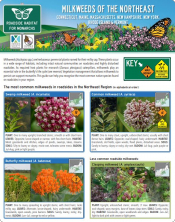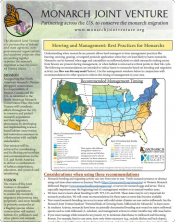
Regional Milkweed Guides
These quick guides help road managers and road maintenance crews recognize milkweeds on roadsides where they work. Milkweeds are required for the development of monarch caterpillars. Being able to identify various milkweed species enables habitat planning and management activities to promote monarch habitat in roadside rights-of-way. Created by The Xerces Society and MJV.
Northeast | Mid-Atlantic | Southeast | Great Lakes | Arkansas-Louisiana-Mississippi | Arizona-New Mexico | California | Colorado | Florida | Iowa-Minnesota | Idaho-Oregon-Washington | Kansas-Missouri | Montana-Wyoming | Nevada-Utah | Oklahoma-Texas

Nectar Plant Guides
Although monarch butterflies are known to nectar on a wide variety of plants (and thus are considered nectar plant generalists), there are many plant species that they rarely or never visit and a smaller number of plant species that they strongly prefer. Documented nectar plants for monarchs are summarized in regional lists at: xerces.org/monarch-nectar-plants.

Best Practices: Herbicides & Weed Control
Noxious and invasive weeds can degrade habitat for monarchs by displacing valuable nectar plants and milkweed. Herbicides are a land management tool to control noxious and invasive weeds or encroaching woody vegetation. However, some herbicide uses have nontarget effects that reduce the quality of habitat for monarchs by removing flowering plants and milkweed plants or reducing plant diversity over time. This guide highlights best management practices to reduce the impacts of herbicides on monarchs. Download the guide: Monarch Butterflies, Weeds, and Herbicides

Best Practices: Mowing & Management
Understanding when monarchs are present allows land managers to time management practices such as burning, mowing, grazing, or targeted pesticide application when they are least likely to harm monarchs. The Monarch Joint Venture and Xerces Society partnered to provide recommendations for the timing of habitat management in both the eastern and western monarch breeding ranges of the United States. Download Mowing & Management: Best Practices for Monarchs
See also the Rights-of-Way as Habitat Working Group website for further information and resources. This group is focused on the utility and transportation sectors. They provide a forum to collaborate and share ideas, best practices, and other information to promote successful habitat projects along rights-of-way.
Other Resources and Links
Resources Library: Rights-of-Way as Habitat Working Group - This online library is a clearinghouse of tools and information related to habitat on rights-of-way and other lands. From seed mix calculators to mowing guidelines and everything in between, you’ll find it here.
Pollinator Habitat Scorecard – The Pollinator Scorecard provides a flexible tool to evaluate habitat quality and the compatibility of management practices with pollinator habitat on rights-of-way and other energy and transportation lands.
Rights-of-Way as Habitat Geospatial Database - The Geospatial Database allows your organization to store and track information about habitat restoration projects and conservation measures on your lands. The database quantifies pollinator habitat managed on energy and transportation rights-of-way (ROW) and other lands to inform habitat restoration activities, communicate the conservation value of ROW, and facilitate collaborative projects between participating organizations.
Pollinator Habitat Conservation Along Roadways - This National Cooperative Highway Research Program project by the Xerces Society looked at successful practices and lessons learned from states where pollinator species are listed; the results are 16 regional guides and associated tools to share this knowledge and to show how to implement integrated pollinator habitat programs.
MJV Literature Review: Monarch Roadside Habitat - Conservation Value & Risks - This informal literature review summarizes research papers relating to roadside habitat for pollinators, the benefits of this habitat, along with associated risks in order to provide practitioners with the latest science on this topic.
Maintaining Roadsides for Pollinators - This guide, written by Pollinator Partnership, provides you with information on roadside enhancements that allow you to maintain safe and accessible roadsides and support pollinators. The information that follows outlines the science and research that lets us develop technical guidelines, case studies of roadside management for pollinators, and background on pollinator biology as a resource.
Monarch Wings Across The Eastern Broadleaf Forest Webinar: Habitat within Rights-of-Ways – In this presentation, Iris Caldwell gives an overview for understanding the importance of managing rights-of-ways as monarch and pollinator habitat and highlights opportunities for collaborative partnerships between rights-of-way managers and the conservation movement.
Pollinator BMPs for Roadsides & Other Rights-of-Way – The Minnesota Department of Ag has a great resource on best management practices for pollinators along roadsides and other right-of-way areas.
Pollinators and Roadsides – This Xerces Society document outlines important practices for managing roadsides for pollinators.

